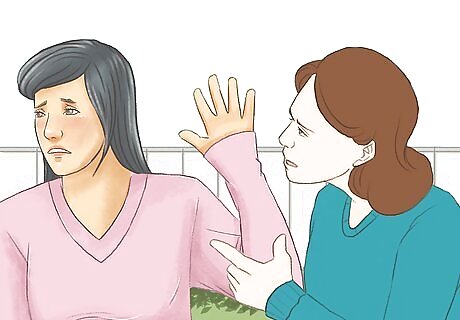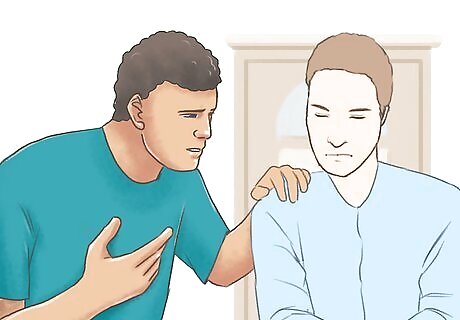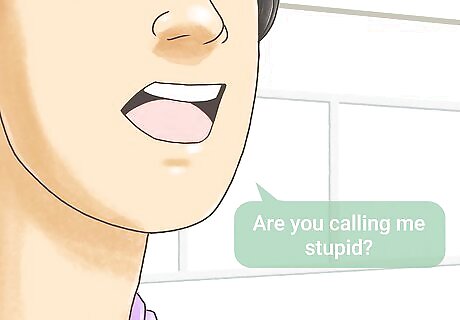
views
X
Research source
The skill of recognizing your own and other people’s insecurities will ultimately benefit you, any situation and relationship. Recognition is the first step toward creating change. This article will increase your awareness about insecurities, which will inspire your efforts to grow and be more understanding of others.
Observing Yourself

Evaluate your self-talk. Do you pay attention to the constant conversation going on in your own head? Self-talk is either productive and positive or negative and detrimental to your well-being. Focusing on your self-determined negative qualities will keep you in a state of insecurity. Harshly judging yourself does no good for anyone. Avoid harshly judging yourself because it produces an unfair representation of you. Picking on yourself is detrimental to your mood, motivation and outlook on life. Look in the mirror each morning and tell yourself three things you like about yourself. The more you point out the positive, the more likely it is that you will build confidence and hush your insecure self-talk. Your negative self-talk may make it difficult for you to speak up for yourself. Positive self-talk will build your ability to speak up for yourself.

Address social situations. There are certain social situations that cause people to feel anxious and insecure. Perhaps you struggle to mingle at parties, talking in front of others or walking down the main hall at school. Sometimes when people don't feel confident or well-versed in a skill, they can feel unsure. The good news is, you can learn to identify and resolve these issues. Social situations may trigger thoughts and feelings that you are not doing the right thing at the right time and you don’t want to be embarrassed. Use visualization techniques to calm yourself. Visualize yourself being comfortable simply observing and enjoying the experience. Seek professional help for social anxiety, which will help you examine and challenge the thoughts that are distorting the reality of the situation, and help build healthy self-esteem. Your insecurities may be manifesting in social situations as bullying behaviors. This is an attempt to control situations to avoid feeling insecure. Find other ways to create success in your life such as cooperating with others rather than forcing your opinion upon them. Notice if you feel uncomfortable expressing your needs and desires to others, which can lead to resentment and frustration. If you only express your needs passively, your needs will likely go unmet, and you may begin to feel anger and contempt. Practice using assertive language to ask for what you need. It will feel uncomfortable at first, but you will ultimately feel more comfortable when your needs start being expressed. A fear of losing safety can motivate negative behaviors. For example, if you get nervous, anxious and lash out at people when you are getting ready to travel, you might be feeling insecure about the uncertainty of your safety.

Ask for feedback from others. There are times when it is helpful to ask others for their opinions. You may not always recognize how you are behaving, so getting input from trusted friends or family can be helpful. They may notice that you get extremely quiet around certain people, or freeze and shut down in certain situations. Not everyone is able to give constructive feedback, so think about a friend or family member that can be honest with you without being abusive, dismissive, or demeaning. Ask that person if they notice that you demonstrate any insecurities. Request that they be completely honest. You might feel vulnerable when asking others for input about you as a person, but your goal is to learn more about yourself so you can lessen your insecurities. An example of good feedback would be something like: "You seem really concerned with fitting in with people you think are cool, and when they're around you get really loud and out of control. I think you are great and have a lot to offer others, and you could work on building your self-confidence." An example of destructive feedback would be: "You're a total weirdo and a slob."

Monitor your response to conflict. In times of upheaval, you may notice your responses are inflamed and you feel defensive. You might also cower and feel ashamed and humiliated. Your actions may differ from one situation to another or in the presence of certain people. Conflict brings out the worst in a lot of people. For example, you might feel insecure about your education because you had trouble reading when you were in elementary school. Then, as an adult someone makes a joke about you missing what was said on a memo. You respond with anger toward the person because their joke triggered an insecurity you have about your reading ability. Think about some of the major conflicts you have had. Try to identify what triggered your response. Your response may have seemed out of proportion to what was said. The underlying feelings that were triggered can usually be tied to an insecurity.
Surveying Others

Observe private circumstances. People generally behave differently in private than they do in public. You may see more open, honest or even outrageous behavior in a private situation. Perhaps people feel more comfortable in private. It is helpful to spot signs of insecurity because it will lead to a more compassionate understanding of others. Look for traits and behaviors such as: jealousy (wary of others and suspecting others of wrong-doing); selfishness (overly focused on own needs with little regard for others); sulking (gains control via fits of moodiness). If you choose to discuss a person’s insecurities, be mindful that it is a sensitive subject. The person may deny a direct question such as, “Are you insecure about my sister spending time with me?” Consider saying something such as, “I’m so grateful to spend time with my sister. I really feel supported by her, which helps me be a happier person all around, which helps us.”

Study public situations. Whether you are in a group of friends, visiting from out of town, or you recently joined a running club, you can identify people’s insecurities by watching and interacting. It can be difficult to connect and relate to a person who has a lot of insecurities. Public displays of insecurities take many forms. Look for traits and behaviors such as: excessive people-pleasing (attempts to please everyone to avoid being disliked); arrogance (an inflated view of oneself and boasts about all accomplishments); excessive competitiveness (turns every situation or conversation into something that must be won); overly materialistic (surrounds themselves with expensive items to convince others they are important). Observe body language as it is another way to identify insecurities. A person who is insecure will hold their body in a slumping, hunching fashion, as if they are trying to hide from the world. The opposite would be true for someone who is confident. They would stand tall and straight with shoulders back and make direct eye contact with others. Avoid publicly confronting someone about their insecurities. Pull the person aside for a private conversation. The person may not be aware they are exhibiting these behaviors. Let them know their behaviors are causing unwanted turmoil by saying, “Hey, I know this might be a sensitive subject, but it appears when you get overly competitive it’s upsetting a lot of people. I didn’t know if you were aware of that.”

Analyze behavioral responses during conflicts. Seeing others become defensive or upset can be difficult to watch. It is also challenging to be a part of such conflicts. When a person is put into a position where they believe they must defend themselves, they will show you their insecurities by way of their reactions. Watch closely and you will better understand the person and their motives. Look for traits and behaviors such as: extreme authoritarian (know-it-alls who bully and boss people around); defensiveness (cannot accept feedback without perceiving it as an attack); extremely passive (won’t fight back or stick up for themselves). Ask yourself the following questions when examining a conflict: If the person gets defensive do they resort to physical abuse? (Always report this to the authorities). Does the person say nothing or agree then have a reaction that is passive-aggressive (an indirect resistance to your request such as procrastinating)? If they are not feeling good about themselves because they lost their job, do they have a short temper, is irritable and doesn’t seem to care about most things?

Analyze verbal responses during conflicts. There are examples of verbal responses caused by underlying insecurities. Understanding these concepts does not excuse negative behavior. Instead, allow it to provide understanding so you can remain safe, remove yourself from the situation, or resolve the conflict once and for all. Ask yourself the following questions when examining the verbal aspects of conflict: When challenged, does the person attack your shortcomings or call you names? Does the person respond with, “Are you calling me stupid?” when you said nothing related to the person’s intellect? Does they hear things that are not said and twist words into an attack upon themselves?
Evaluating Relationships

Decipher attachment insecurities. A person’s ability to emotionally attach to another person in a relationship is heavily influenced by the relationship they had as a child with their primary caregiver. If the caregiver relationship was afflicted with insecurities, it is likely the person’s adult romantic relationships will suffer the same struggles. Precise terms can vary, but generally adult attachment styles fall into four categories. Determine which one you might fall into: Secure: the person easily attaches to others. Anxious-preoccupied: the person wants to be emotionally intimate with others, but the person believes others don’t want to return the favor. Dismissive-avoidant: the person is independent and does not want to rely upon anyone or have anyone depend on them. Fearful-avoidant: the person desires closeness but is insecure about the possibility of getting hurt. If you recognize your style in any of the above, there are things you can do to manage: educate yourself on attachment theory; find a therapist with an expertise in attachment theory; seek partners with secure attachment styles; participate in couples counseling; talk about your relationship.

Examine family dynamics. Your family teaches you many things that you will carry into adulthood. Some things will be life-affirming and wonderful, and other things will be challenging. Many times insecurities are derived from the interactions you had and continue to have within your family, and even affect the types of adult relationships you pursue. List all the members in your immediate family. Next to each name list the positive things this person helped you develop. Then, list the things that you believe contributed to the negative feelings and behaviors you have developed. For example, if your father favored your brother and excluded you from activities because you were a girl, you may believe you will never be good enough. This doesn’t only affect the relationship you have with your father and brother, but it may be a theme that runs through a lot of situations in your adult life.

Explore friendships. The biggest difference between family and friends is that you get to choose your friends. Sometimes you will be closer with your friends than your family members. Insecurities can make friendships challenging at times. Identifying a friends' insecurities and showing empathy toward them will help build a more solid friendship. You may have friends who trigger your insecurities. For example, one of your friends might be extremely attractive and when you go out with them, they get a lot of attention. You feel excluded and unattractive. If this occurs, appreciate your great qualities and focus on having fun rather than judging yourself. On the other hand, if one of your friends is showing their insecurities, use reassurance to help mend the problem. For example, your friend doesn’t get picked for an audition for a school play and berates themselves by saying, “I’m so lame. I knew I was going to blow it. It’s because my nose is too big.” Speak up and say, “You can’t do that to yourself. You are beautiful and smart and remember they are looking for a particular type for the role. It just wasn’t you and it doesn’t mean there won’t be fabulous roles for you later.”

Watch for self-destructive behaviors. It is difficult to watch a friend make poor decisions that affect them and the people who care about them. Unfortunately, insecurities can cause people to do things that may require you or someone else to step in and help. If a friend is being promiscuous it is likely the sign of some deeper issues. A person who uses their sexuality as a way to garner favor with others may be insecure. Your friend is likely valuing themselves based on their sexual attractiveness to others rather than being seen as a complete person. This type of behavior leads to health risks, being taken advantage of and declining self-esteem. Insecurities can lead to people self-medicating with alcohol and drugs. Perhaps a friend gets drunk to feel more confident and relaxed. The degree to which this friend does this is the issue. Addiction is a very serious affliction that requires dedication and professional help to manage. Help yourself or a friend get help by asking a physician or close friend or family member for a referral to a therapist. However, if that is not feasible contact your local department of mental health about counseling.

Dissect working relationships. Insecurities in the workplace can affect your livelihood. When someone in charge is a bully and you must abide by this person’s rule, you must be cautious. Identifying a coworker’s insecurities will prevent you from endangering your job. The goal is to know what the insecurities are so you can avoid discussions and actions that arouse and aggravate them. Someone you work with is not willing to share information with you because they are insecure about their job. Rather than confronting the person, find other sources for the information. If it becomes an extremely difficult situation and threatens your job, then speak to a supervisor about it. Respect the chain of command and ask for suggestions on how to handle the situation. You might work for an online company and never get to see your coworkers face-to-face. This leaves you with extremely limited ways to develop relationships, and any sense of confidence in the longevity of the position. To combat these insecurities, produce great work and let that speak for itself. Focus on building your confidence through methods such as: physical exercise, volunteer work, or join a club that promotes group activities.


















Comments
0 comment